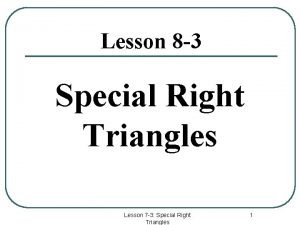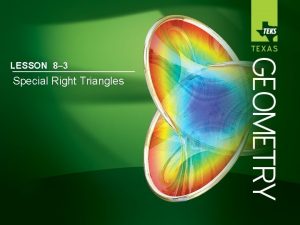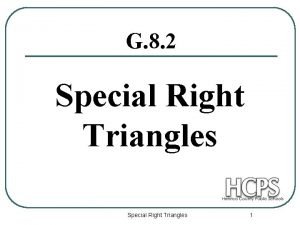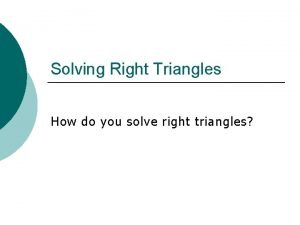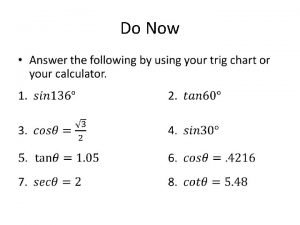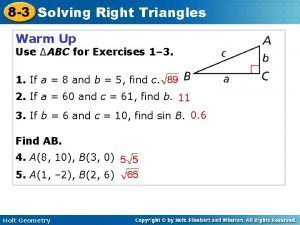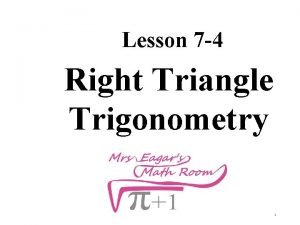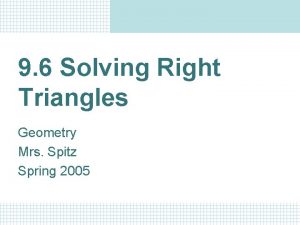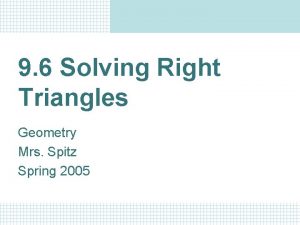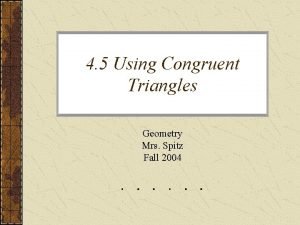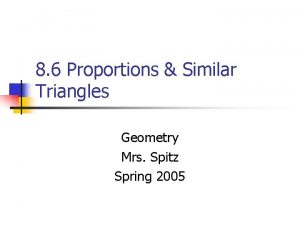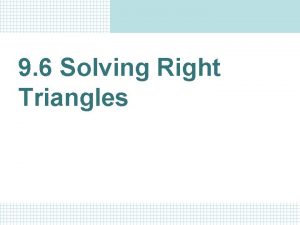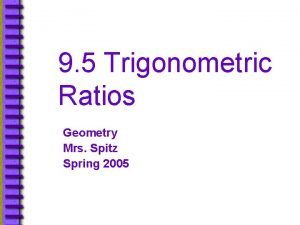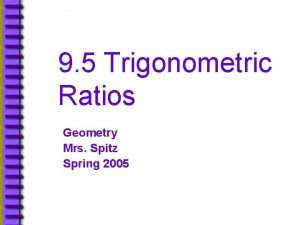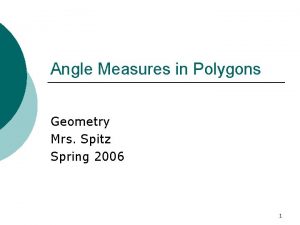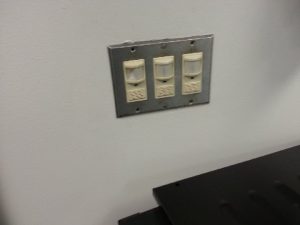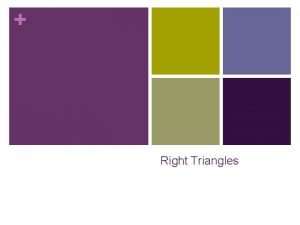Solving Right Triangles Geometry Mrs Spitz Spring 2005














- Slides: 14

Solving Right Triangles Geometry Mrs. Spitz Spring 2005

Objectives/Assignment • Solve a right triangle. • Use right triangles to solve real-life problems, such as finding the glide angle and altitude of a space shuttle. • To solve problems like determining the correct dimensions of a wheel-chair ramp.

Solving a right triangle • Every right triangle has one right angle, two acute angles, one hypotenuse and two legs. To solve a right triangle, means to determine the measures of all six (6) parts. You can solve a right triangle if the following one of the two situations exist: – Two side lengths – One side length and one acute angle measure

Note: • As you learned earlier, you can use the side lengths of a right triangle to find trigonometric ratios for the acute angles of the triangle. As you will see in this lesson, once you know the sine, cosine, or tangent of an acute angle, you can use a calculator to find the measure of the angle.

WRITE THIS DOWN!!! • In general, for an acute angle A: – If sin A = x, then sin-1 x = m A – If cos A = y, then cos-1 y = m A – If tan A = z, then tan-1 z = m A The expression sin-1 x is read as “the inverse sine of x. ” • On your calculator, this means you will be punching the 2 nd function button prior to doing the calculation. This is to find the degree of the angle.

Example 1: • Solve the right triangle. Round the decimals to the nearest tenth. HINT: Start by using the Pythagorean Theorem. You have side a and side b. You don’t have the hypotenuse which is side c—directly across from the right angle.

Example 1: (hypotenuse)2 = (leg)2 + (leg)2 c 2 = 32 + 22 c 2 = 9 + 4 c 2 = 13 c = √ 13 c ≈ 3. 6 Pythagorean Theorem Substitute values Simplify Find the positive square root Use a calculator to approximate

Example 1 continued • Then use a calculator to find the measure of B: Key Strokes -

Finally • Because A and B are complements, you can write m A = 90° - m B ≈ 90° - 33. 7° = 56. 3° The side lengths of the triangle are 2, 3 and √ 13, or about 3. 6. The triangle has one right angle and two acute angles whose measure about 33. 7° and 56. 3°.

Ex. 2: Solving a Right Triangle (h) • Solve the right triangle. 25° Round decimals to. You theare looking for opposite and nearest tenth. hypotenuse which is the sin ratio. sin H = 13 sin 25° = opp. hyp. h 13 13(0. 4226) ≈ h 5. 5 ≈ h Set up the correct ratio 13 Substitute values/multiply by reciprocal Substitute value from table or calculator Use your calculator to approximate.

Ex. 2: Solving a Right Triangle (g) • Solve the right triangle. 25° Round decimals to You theare looking for nearest tenth. adjacent and hypotenuse which is the cosine ratio. cos G = adj. hyp. g 13 cos 25° = 13 13(0. 9063) ≈ g 11. 8 ≈ h Set up the correct ratio 13 Substitute values/multiply by reciprocal Substitute value from table or calculator Use your calculator to approximate.

Using Right Triangles in Real Life • Space Shuttle: During its approach to Earth, the space shuttle’s glide angle changes. • A. When the shuttle’s altitude is about 15. 7 miles, its horizontal distance to the runway is about 59 miles. What is its glide angle? Round your answer to the nearest tenth.

Solution: • You know opposite and adjacent sides. If you take the opposite and divide it by the adjacent sides, then take the inverse tangent of the ratio, this will yield you the slide angle. Glide = x° 15. 7 miles 59 miles tan x° = opp. adj. 15. 7 Use correct ratio Substitute values 59 Key in calculator 2 nd function, tan 15. 7/59 ≈ 14. 9 When the space shuttle’s altitude is about 15. 7 miles, the glide angle is about 14. 9°.

B. Solution Glide = 19° h • When the space shuttle is 5 miles from the runway, its glide angle is about 19°. Find the shuttle’s altitude at this point in its descent. Round your answer to the nearest tenth. The shuttle’s altitude is about 1. 7 miles. 5 miles tan 19° = 5 tan 19° = opp. adj. Use correct ratio h Substitute values 5 h 5 5 Isolate h by multiplying by 5. 1. 7 ≈ h Approximate using calculator
 Right product right place right time right price
Right product right place right time right price Family time
Family time Special right triangles 8-3
Special right triangles 8-3 8-3 special right triangles answers
8-3 special right triangles answers Soecial right triangle
Soecial right triangle Horizontal
Horizontal Solve the right triangle
Solve the right triangle 8-3 lesson quiz
8-3 lesson quiz Lesson 8-3 solving right triangles
Lesson 8-3 solving right triangles Adj hyp opp
Adj hyp opp The right man on the right place at the right time
The right man on the right place at the right time Spitz hospitalizáció
Spitz hospitalizáció Preadoleszcens
Preadoleszcens Gabriel spitz
Gabriel spitz Gabriel spitz
Gabriel spitz


